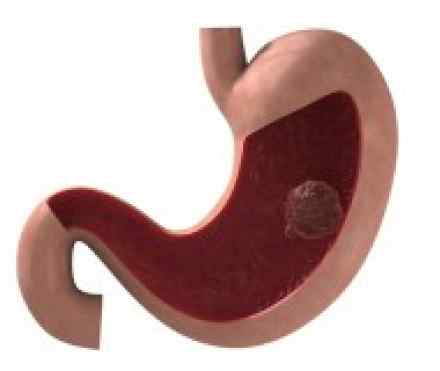
What is it?
Stomach cancer is cancer that occurs in the stomach — the muscular sac located in the upper middle of your abdomen, just below your ribs. Your stomach is responsible for receiving and holding the food you eat and then helping to break down and digest it.
Another term for stomach cancer is gastric cancer. These two terms most often refer to stomach cancer that begins in the mucus-producing cells on the inside lining of the stomach (adenocarcinoma). Adenocarcinoma is the most common type of stomach cancer.
Symptoms
Signs and symptoms of stomach cancer may include:
- Fatigue
- Feeling bloated after eating
- Feeling full after eating little
- Heartburn
- Indigestion
- Nausea
- Stomach pain
- Vomiting
- Weight loss
Causes
Doctors aren't sure what causes stomach cancer. There is a strong correlation between a diet high in smoked, salted and pickled foods and stomach cancer. As the use of refrigeration for preserving foods has increased around the world, the rates of stomach cancer have declined.
In general, cancer begins when an error (mutation) occurs in a cell's DNA. The mutation causes the cell to grow and divide at a rapid rate and to continue living when normal cells would die. The accumulating cancerous cells form a tumour that can invade nearby structures. And cancer cells can break off from the tumour to spread throughout the body.
Types of stomach cancer
The cells that form the tumor determine the type of stomach cancer. The type of cells in your stomach cancer helps determine your treatment options. Types of stomach cancer include:
- Cancer that begins in the glandular cells (adenocarcinoma). The glandular cells that line the inside of the stomach secrete a protective layer of mucus to shield the lining of the stomach from the acidic digestive juices. Adenocarcinoma accounts for more than 90 percent of all stomach cancers.
- Cancer that begins in immune system cells (lymphoma). The walls of the stomach contain a small number of immune system cells that can develop cancer. Lymphoma in the stomach is rare.
- Cancer that begins in hormone-producing cells (carcinoid cancer). Hormone-producing cells can develop carcinoid cancer. Carcinoid cancer is rare.
- Cancer that begins in nervous system tissues. A gastrointestinal stromal tumor (GIST) begins in specific nervous system cells found in your stomach. GIST is a very rare form of cancer.
Because the other types of stomach cancer are rare, when people use the term "stomach cancer" they generally are referring to adenocarcinoma.
Risk factors
Factors that increase your risk of stomach cancer include:
- A diet high in salty and smoked foods
- A diet low in fruits and vegetables
- Eating foods contaminated with aflatoxin fungus
- Family history of stomach cancer
- Infection with Helicobacter pylori
- Long-term stomach inflammation (chronic gastritis)
- Pernicious anaemia
- Smoking
- Stomach polyps
Diagnosis
Tests and procedures used to diagnose stomach cancer include:
- A tiny camera to see inside your stomach (upper endoscopy). A thin tube containing a tiny camera is passed down your throat and into your stomach. Your doctor can look for signs of cancer. If any suspicious areas are found, a piece of tissue can be collected for analysis (biopsy).
- Imaging tests. Imaging tests used to look for stomach cancer include computerized tomography (CT) and a special type of X-ray sometimes called a barium swallow.
Determining the extent (stage) of stomach cancer
The stage of your stomach cancer helps your doctor decide which treatments may be best for you. Tests and procedures used to determine the stage of cancer include:
- Imaging tests. Tests may include CT, positron emission tomography (PET) and X-ray.
- Exploratory surgery. Your doctor may recommend surgery to look for signs that your cancer has spread beyond your stomach within your abdomen. Exploratory surgery is usually done laproscopically. This means the surgeon makes several small incisions in your abdomen and inserts a special camera that transmits images to a monitor in the operating room.
Other staging tests may be used, depending on your situation.
Stages of stomach cancer
The stages of adenocarcinoma stomach cancer include:
- Stage I. At this stage, the tumor is limited to the layer of tissue that lines the inside of the stomach. Cancer cells may also have spread to nearby lymph nodes.
- Stage II. The cancer at this stage has spread deeper, growing into the muscle layer of the stomach wall. Cancer may also have spread to the lymph nodes.
- Stage III. At this stage, the cancer may have grown through all the layers of the stomach. Or it may be a smaller cancer that has spread more extensively to the lymph nodes.
- Stage IV. This stage of cancer extends beyond the stomach, growing into nearby structures. Or it is a smaller cancer that has spread to distant areas of the body.
References
http://www.medicinenet.com/stomach_cancer/article.htm
http://www.webmd.com/cancer/stomach-gastric-cancer
http://www.mayoclinic.org/diseases-conditions/stomach-cancer/home/ovc-20202327
https://www.hse.ie/eng/health/az/C/Cancer,-stomach/

